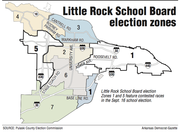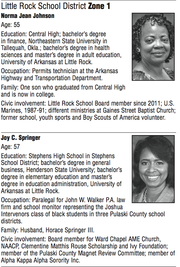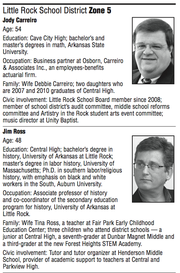Buildings and budgets will demand a greater share of the Little Rock School Board's attention as the state's largest district plans for the loss of state desegregation aid while working to build and renovate school campuses.
RELATED ARTICLES
http://www.arkansas…">Vote to settle 2 races in NLR districthttp://www.arkansas…">Yearly millage votes loom on Pulaski County ballots
The issues are also at the forefront in the campaigns of candidates running for election Tuesday to the Zones 1 and 5 seats on the Little Rock School Board.
Incumbent Norma Jean Johnson and challenger Joy C. Springer are running in Zone 1, which encompasses east and downtown Little Rock.
Incumbent Jody Carreiro and challenger Jim Ross are running in Zone 5, which covers a portion of west Little Rock.
The unpaid term of office is for three years.
Early voting can be done from 8 a.m. to 5 p.m. Monday at the Pulaski County Regional Building at 501 W. Markham St. in Little Rock. Polls Tuesday will be open from 7:30 a.m. to 7:30 p.m. only in the two zones that have the contested School Board races.
In Zone 1, Johnson, a former Marine and permits clerk at the Arkansas Highway and Transportation Department, and Springer, a paralegal for the John W. Walker P.A. law firm, have raised vastly different amounts of money for their campaigns.
Johnson reported receiving $700 in itemized contributions by a Sept. 6 deadline and spending $1,064.
Springer reported total contributions of $14,779 and expenditures of $9,578.
Johnson and Springer differ somewhat in their positions on updating school buildings to meet the district's short- and long-term needs, efforts that are expected to require an election on a property tax increase.
Johnson said she is open to building some new schools, renovating others and "re-purposing" still others -- some of which might be in her east Little Rock zone. Johnson said she would only support closing a school if it is structurally unsafe.
Springer said repurposing schools such as Carver Elementary and/or Rockefeller Elementary into prekindergarten centers is the same as closing the elementary schools. Springer said she would oppose closing or repurposing schools and any millage increase proposals tied to a building plan that includes closing the schools in her zone.
Springer said she would "definitely" support new schools in southwest Little Rock. On the more specific, more contentious recommendation from consultants that a new McClellan school be built on Richsmith Lane, a distance away from the current McClellan site, Springer said she would listen to patrons and seek public support for any plan for the high school.
Johnson, in her campaign, believes the school system and School Board are capable of making the budget cuts necessary -- away from the students -- to offset the loss of $37 million a year in state desegregation aid.
Springer, in her campaign, said the district will be able to make up the funding loss in ways that include reducing legal fees and decisions that result in lawsuits, and reducing costs tied to the administration of the district.
In Zone 5, Carreiro, a partner in an employees-benefits actuarial firm, has raised $4,050 for his campaign and spent $2,516.71, according to a report filed with the Pulaski County clerk's office. Ross, an associate professor of history at the University of Arkansas at Little Rock, had raised $6,326 and spent $5,191 by the reporting deadline.
The candidates approach the budget and facilities issues in different ways. "There's going to be fewer people working for the district in five years. That's the no-brainer," Carreiro said about the budget, adding that the district must more efficiently manage employee benefits. "Right-sizing" elementary schools at 500 to 600 pupils will lead to savings, and the district can expect revenue increases from recent retail development and increasing student enrollment, he said.
As for the specifics of the facilities recommendations, Carreiro is supportive of a new west Little Rock middle school and new high school in southwest Little Rock, both of which, he said, will reduce the strain on existing schools and ensure that all schools have space to offer a curriculum in the arts and technology.
As for a new high school in west Little Rock, Carreiro described that as a long-term priority, to be finalized after the smoke clears on any chance of a possible reorganization of school district lines in Pulaski County. Some people have speculated about merging the Little Rock district with the portion of the Pulaski County Special district that is south of the Arkansas River.
"I don't think the high school is a five- or six-year priority. If you put the high school on that list, it would be the last thing needed to be done. Maybe it's the first thing for the next facilities study."
Ross said the district must rebuild public trust to have a chance at winning voter support for a property tax increase for building and other operating costs in the district. He recommended doing that in part by cutting as much as $70 million a year in expenditures from the district's $330 million budget and building up the district's savings.
If he had his druthers, Ross said he would replace both J.A. Fair and McClellan high schools with a new high school in a densely populated part of south Little Rock. He would like to expand Central High, make Hall High a science, technology and arts school, and turn Parkview High into an arts academy for which students would audition to attend. A new high school would serve the northwest part of the city.
"That was our dream," Ross said and added, "We've got to figure out how to reconfigure these schools so that parents feel the schools are safe and that their children are getting a quality education. The reality is the city is moving along the southern edge and the northern edge to the west. The reality is that within the next 10 years we're going to need a high school."
With strong leadership and careful spending, Ross said, the district can end historical divisions within that are based on race and class, and meet the needs of students citywide.
"We are going to have to have more money," Ross said. "That's not a bad thing because we want to invest in our kids, but we don't want to throw money into the empty vault of six-figure administrators and programs that aren't doing anything."
Metro on 09/14/2014



